ASUS P8Z68-V PRO Review: Our First Z68 Motherboard
by Ian Cutress on May 11, 2011 3:13 AM EST- Posted in
- Motherboards
- Asus
- Z68
3D Movement Algorithm Test
The first benchmark ran is actually one I have written. My full time job involves computational chemistry, so this first benchmark uses various algorithms for three-dimensional simulation and movement of independent particles. The algorithms both employ uniform random number generation or normal distribution random number generation, and vary in various amounts of trigonometric operations, conditional statements, generation and rejection, fused operations, etc. The benchmark runs through six algorithms for a specified number of particles and steps, and calculates the speed of each algorithm, then sums them all for a final score. This is an example of a real world situation that a computational scientist may find themselves in, rather than a pure synthetic benchmark. The benchmark is also parallel between particles simulated, and we test the single thread performance as well as the multi-threaded performance.
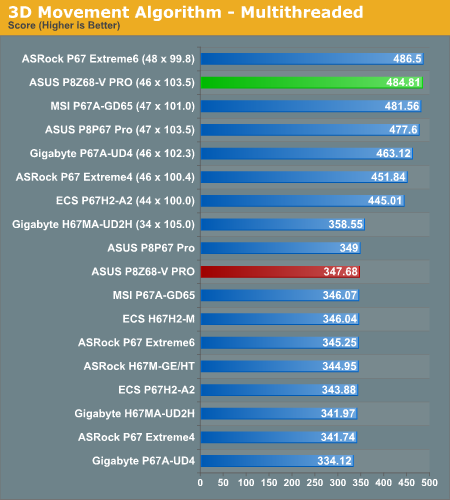
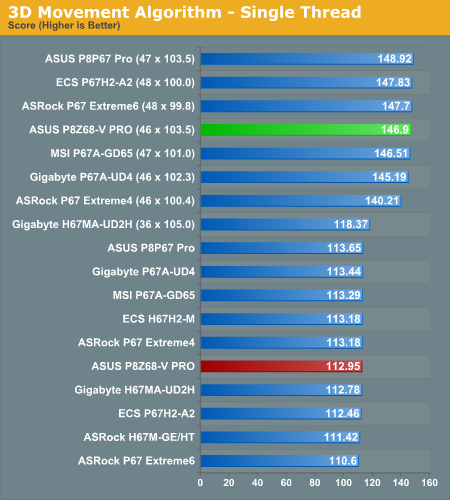
WinRAR x64 3.93
With 64-bit WinRAR, we compress the set of files used in the USB speed tests. WinRAR x64 3.93 attempts to use multithreading when possible.
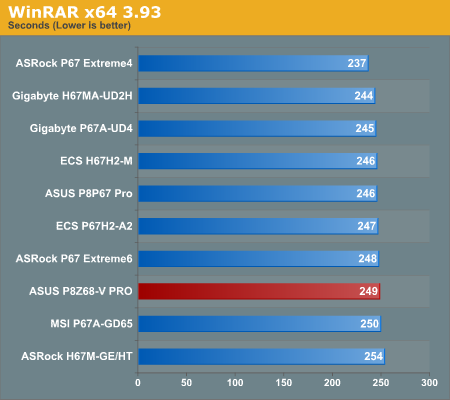
FastStone Image Viewer 4.2
FastStone Image Viewer is a free piece of software I have been using for quite a few years now. It allows quick viewing of flat images, as well as resizing, changing color depth, adding simple text or simple filters. It also has a bulk image conversion tool, which we use here. The software currently operates only in single-thread mode, which should change in later versions of the software. For this test, we convert a series of 170 files, of various resolutions, dimensions and types (of a total size of 163MB), all to the .gif format of 640x480 dimensions.
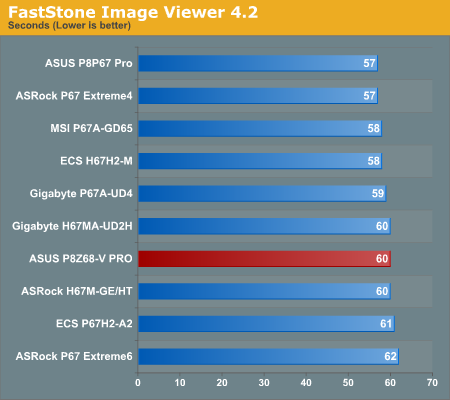
Sorenson Squeeze 6.0
Sorenson Squeeze is a professional video encoder, complete with a vast array of options. For this test, we convert 32 HD videos, each a minute long and approximately 42 MB in size, to WMV 512KBps format. Squeeze can encode multiple videos at once, one for each thread.
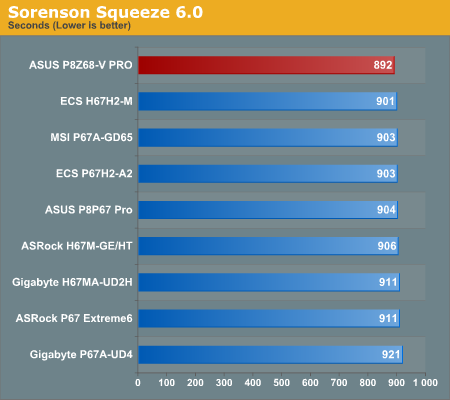
The ASUS does relatively well in our Computation bench suite, with an excellent Squeeze score. It's not the fastest board so far, but the difference between the slowest and fastest board in each test is only 3-9%, so for stock performance it's not something generally noticeable in day to day use.










95 Comments
View All Comments
AnnihilatorX - Wednesday, May 11, 2011 - link
I wonder when will MB makers start to support onboard multichannel LPCM HDMI audio ?NeBlackCat - Wednesday, May 11, 2011 - link
Would Anandech please remember that some of us care more about running our systems as energy sparingly as possible, and pay as much attention to underclocking/volting as you do to overclocking/volting.It's becoming quite the thing to do, you know. In mid 2011 I really shouldn't have to ask.
NeBlackCat - Wednesday, May 11, 2011 - link
Oops I accidentally posted that as a reply.But since I'm back - any chance you would do a follow up review of the board from an energy saving viewpoint, and incorporate this IMPORTANT aspect into all further board/system reviews, Anandtech?
Dreamwalker - Wednesday, May 11, 2011 - link
Seriusly, if you are after a low power consumption system go look elswhere (Atom, AMD E series, ITX boards...).This segment is made to get the maximum out of your rig and not vice versa.
xinaes - Wednesday, May 11, 2011 - link
Surely these things needn't be polarized. It is not unreasonable to want to know what kind of balance of performance and power can be achieved with any given level of hardware. Also, why should someone interested in economising power not be interested in something like QuickSync, for example?aegisofrime - Wednesday, May 11, 2011 - link
I agree with NeBlackCat. Low power consumption doesn't necessary mean low performance. I for one, undervolt my Phenom II 955. It's a nice balance between performance and power consumption.That said, I have researched undervolting Sandy Bridges before and they seem to do that quite well.
vol7ron - Wednesday, May 11, 2011 - link
I'd also like to know for HTPCs, but I feel if I went that route, I'd stick to an H67 and Core i3/i5 for the cost savings.Still, this is obviously not a complete review, but undervol7ing is something to keep in mind. :)
L. - Thursday, May 12, 2011 - link
2011HTPC
H67 / Z68 / Intel in general
The above three elements are incompatible.
Today, HTPC = E350
Tomorrow, HTPC = E350-likes
For a technical sidenote, undervolting and underclocking are two practices that have been promoted by the lack of chips at every consumption level.
However, again, this is 2011 and you have chips ranging from 1Watt to 125 Watts with steps of maximum 5Watts along the way.
The important fact there is that a chip designed to run @ 18Watts (like an E350) will beat any chip running at that TDP but not designed for it (like an OC'd lower chip or a DC'd higher chip).
As a summary, undervolting is a little fine-tuning you can apply in the end, but it is secondary to picking the correct chip to begin with.
Sandy Bridge can undervolt decently, but seriously WTF.. if you don't need the power, don't pay for it ?
If you're going to undervolt then there's a fairly high chance you're buying the wrong chip.
NeBlackCat - Friday, May 13, 2011 - link
I completely disagree with that.The whole point is that Z68/Sandy Bridge is getting close to giving us the full spectrum of power/performance possibilities in one box (I suspect Ivy Bridge will finish the job), so you DONT have to pick one CPU with one particular profile, and then be restricted in what you can do.
For example:
I may want my HTPC to run at minimal power/noise when watching a movie, but there'll also be times when I want it to rip through an encode as quickly as possible, and don't care if it sounds like a helicopter and glows like hot coal in the process. How nice if i can have both at whim, just with a clock/volt change from a GUI.
I may want my home server to run frugally when just firewalling and media streaming but, when I want to compile that Linux distro...
... and so on.
Z68/Sandy Bridge is perfect for either of the above scenarios. But where hardware/BIOS/tool vendors give us ability to absolutely minimise power/thermals, reviewers don't cover it. Not even a mention of the specs (how low can that vcore go, etc).
They should.
rmoan1 - Wednesday, May 18, 2011 - link
This is silly to me.If you are not using the power then let it auto adjust down at the CPU level. Its like asking if you can fill a Ferrari with regular gas?
Thou I understand why, there is no reason to spend time finding out, none that I can see anyway. If you want to run a media server, along with a browsing PC, etc etc... you can boot into the BIOS OS that comes with all ASUS Boards. You can get a media center ULV PC, etc.. etc... for $300. Or better yet get a tablet when you dont need the full power of your PC.
At the end of the day, you arent getting WD Greens, low power cards, low power RAM, or a smaller PSU or the Green version of the motherboard.
This a performance board that is used for OCing and will be used for OCing.
If you are looking to save energy then stick to a Prius not a Ferrari.